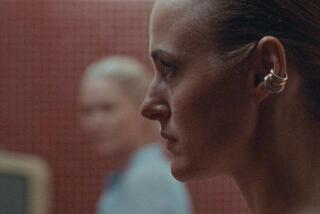Blue Palm: Dancing Around the Ordinary
- Share via
He’s 35, tall, blond and muscular, square-jawed and pony-tailed. She’s 29, petite, dark, sharp-featured, wears her hair pulled tightly back. He talks quickly, his words often repeating and bouncing off each other in a rhythmic scat. Her speech is more measured, orderly. He’s San Francisco born and bred; she’s the daughter of a French father and American mother, reared on both continents. He favors jeans and a T-shirt. She’s eclectic-chic, with Day-Glo replicas of the Eiffel Tower dangling from her ears.
Separately, they’re Tom Crocker and Jackie Planeix. Together, they’re Blue Palm, a performance duo whose movement-based works “Dance Talks!” (at the Saxon-Lee Gallery) and “Amour” (at the Wallenboyd) are first-ups in Pipeline’s Foreign Theatre Festival.
Trained as dancers--they met 13 years ago at Maurice Bejart’s interdisciplinary school in Brussels--the two have developed their own brand of theater: a showy, vibrant, often sardonic blend sparked by their personalities, modern dance and thematic texts--which they deliver in French and English.
(As for the differences in expressing each language in physical terms--”English works with words and sound,” said Planeix. “It’s not as melodious as French. French is nice to hear, but it doesn’t have any rhythms and is actually pretty flat. English is more forceful and dynamic.”)
“ ‘Dance Talks!’ has to do with the life of a dancer,” Crocker explained. “The traveling, touring, choreographers who direct traffic on other people’s bodies, songs, poems and stories. It’s the smell of the dance studio, the sweat at the barre, the texture of the leotards, the wool on your legs, trying to attain this aesthetic/artistic/physical ideal while people outside are going about their lives, making a living, changing, evolving. The dancer is there every day: facing himself, his mirror image. It’s the stuff that’s never talked about. But it’s hidden in a dancer’s muscles; there’s a whole memory there. And it’s rich, rich as hell.”
They’ve also tapped a wealth of personal feelings in “Amour.” Said Planeix, “We wanted to show the image of a couple: positive, young, hip, physical, sensual--and provocative.” Crocker described the work as “a passion parade, a party, an explosion of our love, a desire for fun, wit, play.” He smiled. “I think we’re like those characters in the ‘30s movies: William Powell and Myrna Loy and--what was the dog’s name?--Asta. They were always together, playing, having racy dialogue.”
“We do spend all our time together,” Planeix noted of the 10-year relationship. (They married last August.) “Of course, some things are separate: We work out separately, we think separately. And there’s something very autonomous about the work.” It leads, as Crocker says delicately, “to a lot of creative rubbing.” A sigh. “We’re always going through each other’s meat grinder.
“We’re not the same. We’re very different physically. We’re different in the way we move and the way our heads work. We have different points of view. But the union is beyond that.”
It was that same confidence that enabled them to break with Bejart.
“We left because we had to get out of there,” Crocker said bluntly. “We were lucky to have dealt with a big theatrical mind--but at the same time, you’re trying to evolve, trying to become something other than one of his beautiful, exotic instruments. He was into being a father figure; he was the star.”
There are no ill feelings. Said Planeix: “A lot of the things we did in that school (studies included modern dance, ballet and flamenco, plus music, theater and voice) were the same steps people take towards creation in small theater: a chance to lead people around, make them do what you want, put your vision out there.”
For them, part of that vision has always held a modern, comic edge.
“In France, dance is very structured, very old-world,” Planeix said. “(Americans) have a great sense of humor; the French are not so good at it.”
Added Crocker: “You’re always afraid to be funny. Dance is all the time trying to be beautiful, to be the perfect person. Trying to be funny, you feel like you’re being stupid. In Europe it’s even harder. It’s not even considered art if it’s funny. So coming out of dance and a structured French cultural background was a real struggle for us. It took a real belief that there was something there.”
What that is--and how long it should last--is less clear.
“I don’t care if the effect goes away afterward,” Crocker shrugged, addressing a recent Times review of the program’s effervescent quality. “I think our vitality should wipe away those concerns. It’s real, it’s heartfelt. We’re not interested in creating a major piece of art. No. We want to create something marvelous, fun, in the moment. You don’t pose those kinds of (criteria) for rock ‘n’ roll. Bands can be fun and exotic: Kid Creole, the Chili Peppers--but when you go into a theater, you want to be haunted by images? I think that’s trash.”
Planeix and Crocker have a higher opinion of themselves.
“We’re really glad to be in Los Angeles right now,” he said. “Our intention is to move away from straight dance and into being a performing couple--in television, film, whatever. You haven’t heard the last of us.”
More to Read
The biggest entertainment stories
Get our big stories about Hollywood, film, television, music, arts, culture and more right in your inbox as soon as they publish.
You may occasionally receive promotional content from the Los Angeles Times.










